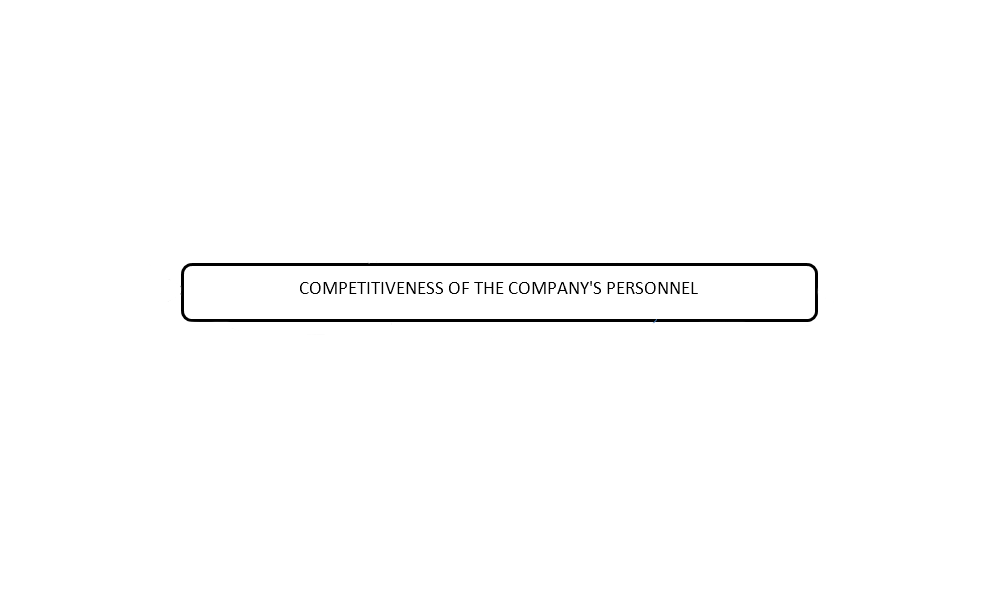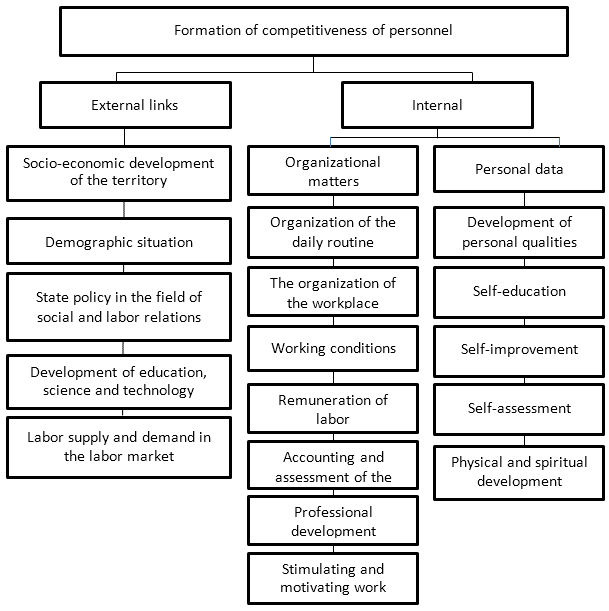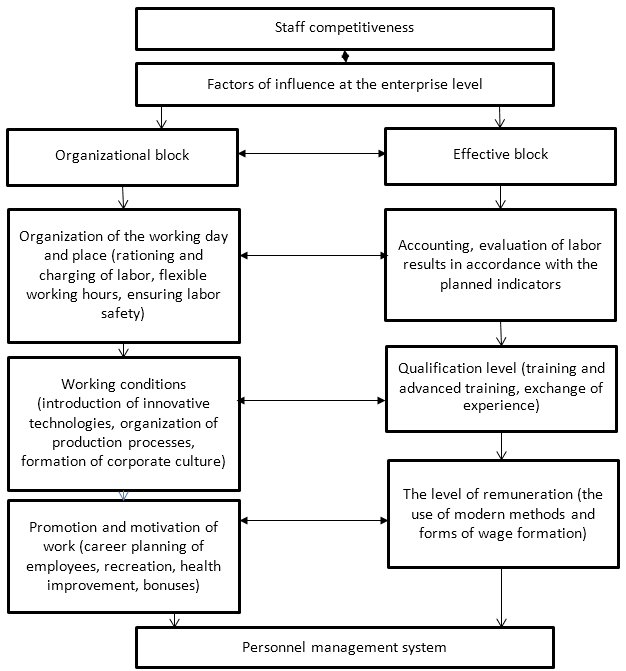Improving the mechanism for managing the competitiveness of the organization's personnel
Content
- Introduction
- 1. Relevance of the topic
- 2. Purpose and objectives of the study, planned results
- 3. Competitiveness as an object of personnel management
- 4. Formation of the enterprise personnel competitiveness management system
- Conclusions
- List of sources
Introduction
In modern economic conditions, personnel is the main resource of the enterprise, as well as a factor in the formation and ensuring the competitiveness of the enterprise. Effective personnel management is one of the main tasks for ensuring the competitiveness of the enterprise and achieving its strategic goals. The presence of highly qualified employees allows the company to form additional competitive advantages in the labor market.
1. Relevance of the topic
Human resources are characterized by their limitations and significant professional potential, which must be continuously improved and developed. The ultimate goal of personnel competitiveness is to increase the labor efficiency associated with the reproduction of demand and the satisfaction of the constantly changing and increasing needs of the employer in the process of implementing economic activities. The competitiveness of the company's personnel is determined by the competitiveness of individual employees or their groups, and, to a large extent, depends on the mechanism of their functioning in the production process. The formation of personnel competitiveness is influenced by factors of the external and internal environment. In the formation of personnel competitiveness, the coherence of all processes of the personnel management system is manifested.
2. Purpose and objectives of the study, planned results
The purpose of the work is to deepen the theoretical foundations and develop methodological aspects of the development of the management system for the competitiveness of the company's personnel as an object of management.
Achieving this goal requires solving the following tasks:
- to study the features of competitiveness as an object of personnel management;
- to reveal the essence of the formation of the enterprise personnel competitiveness management system;
- develop recommendations and suggest approaches to assessing the competitiveness of the company's personnel.
The object of the study is the processes of development of the management system for the competitiveness of the company's personnel.
The subject of the research is a set of theoretical, methodological and applied problems of the development of the enterprise personnel competitiveness management system.
Based on the results of the work, recommendations for managing the competitiveness of the company's personnel will be developed and an assessment of determining the characteristics of personnel competitiveness will be offered.
3. Competitiveness as an object of personnel management
In the conditions of instability of the market economy, the leading positions of enterprises are increasingly determined by personnel who are focused on obtaining competitive advantages in labor results, educational and qualification level, capable of professional development, development and implementation of innovations. In view of this, improving the competitiveness of personnel is an urgent problem for most business entities.
The essence of the term competition was first revealed by A. Smitt, who compared competition with an invisible hand that controls the world in market conditions. It is necessary to pay attention to the fact that the concept of personnel management and the issues of improving the efficiency of its use are not new, in contrast to the category of personnel competitiveness, which is in its infancy and has a debatable nature [1].
The result of the competition of the labor force is its competitiveness in the labor market, which is evaluated through qualitative, quantitative and cost characteristics [2].
Currently, more and more theories in the direction of managing the competitiveness of enterprise personnel are reduced to the assessment of their competencies. In accordance with this approach, the employees of the enterprise can be distinguished by low, medium and high levels of competitiveness.
A low level of personnel competitiveness is typical for employees who have an unacceptably low level of development in some of the components or several at the same time in comparison with the necessary one.
The average competitiveness of the personnel characterizes workers who have only a partial correspondence of the level of development of the components of labor potential requirements and self-assessment of the competitiveness of less confidence in the stability of their employment within the enterprise and beyond.
A high level of personnel competitiveness is achieved at such a level of development of the components of the employee's labor potential (professional, qualification, personal, psychological, organizational), when the employee's potential almost completely meets the requirements of production and according to the results of self-assessment, the employee is not afraid to be out of work [3].
In view of this, the competitiveness of the company's personnel is a multi-factor model, which is based on a competence-based approach [4].
The process of managing the competitiveness of personnel should cover the implementation of four stages:
Stage 1 – implementation of activity management functions, which consists in planning and organizing the process of ensuring competitiveness, motivating employees, monitoring and regulating the process of ensuring competitiveness.
Stage 2 – formation of management methods with the development of appropriate plans (economic, organizational and administrative, socio-psychological).
Stage 3 – formalization of management methods, that is, the development of orders and instructions to ensure competitiveness on the basis of organizational and administrative documents.
Stage 4 – development and adoption of management decisions to determine the degree of achieving competitiveness, evaluation of the effectiveness of management decisions, formation of management activities [5].
4. Formation of the enterprise personnel competitiveness management system
To achieve a more stable competitive position, the company must constantly develop personnel development programs aimed at improving the professional and educational level. The constant growth of professional skills, the acquisition of additional competencies, and the continuous educational process are at the heart of staff development.
The company's personnel competitiveness management system has a rather complex structure. Among the components of the elements can be identified: demographic, socio-cultural, market, organizational, personal-psychological, functional, professional and educational-qualification components (Fig. 1).
The distinctive features of the competitiveness of the company's personnel are: relativity, dynamism, target character, weak formalization, complexity of perception, dualistic understanding and incomplete dependence on the company.
Relativity – the characteristics of the company's personnel, which, when determining its competitiveness, should be compared with any standard, but not with the same characteristics of previous periods, but with similar characteristics of competitors.
Dynamic performance – the competitiveness of the company's personnel can change over time, and such changes can be continuous as a result of changes in the external environment. Even in conditions of constant objective characteristics of personnel, their competitiveness characteristics can both increase and decrease.
Target character – the competitiveness of the company's personnel is related to the goals of the company and depends on the state of the external environment. The same personnel can be competitive in achieving the same goals or in a stable external environment, and uncompetitive in a changing external environment or other goals of the enterprise.
The duality of understanding the competitiveness of personnel lies in its dual essence: it simultaneously characterizes the current state of the labor potential and the future potential of its labor in the context of creating a competitive product or service.
Incomplete dependence on the company is explained by the inability to subordinate certain characteristics of the staff (for example, the level of motivation), so it is possible to improve them or stimulate their improvement only indirectly. On the other hand, any changes in the external environment, regardless of the aspirations of the company's management, can contribute to a change in the competitiveness of personnel [3].

Figure 1 – Competitiveness of the company's personnel
(the animation consists of 9 frames with a delay of 500 ms between frames, the number of playback cycles – 3, size – 55 kilobyte)
The management system of the company's personnel competitiveness is determined by the factors of the external and internal environment (fig. 2).

Figure 2 – Factors affecting the competitiveness of personnel
The external factors of the formation of the competitiveness of the company's personnel include: socio-economic conditions of the development of the region and the country; demographic situation; state policy in the field of social and labor relations; the level of development of education, science and technology; the demand and supply of labor in the labor market [4].
The socio-economic conditions of territorial development determine the social needs and interests, as well as the directions of economic development in general. This factor coordinates the personal needs and interests of people through appropriate means of state and regional regulation. In accordance with the socio-economic conditions of development, demand and supply are formed in the markets of goods and services, human capital, and on this basis, the state policy in the field of labor relations.
The improvement of science, education and technology are direct factors influencing the competitiveness of personnel. The development of science and technology is impossible without the reform of education in accordance with modern scientific and technical achievements that generate the competitiveness of personnel [5].
Supply and demand in the labor market encourages the formation and determines the factors of influence, both at the enterprise level and at the individual level, to improve the competitiveness of personnel.
The demographic situation determines the composition and nature of human capital, its distribution among the branches of the national economy, and on this basis forms their competitive advantages.
The internal factors, which are determined by the company, include: organization of working time, workplace organization, and the creation of working conditions for staff, staff wages, and evaluation of the results of labor, increasing the level of staff skills, incentives and motivation [7].
The factors of managing the competitiveness of the company's personnel represent an interacting sequence of measures that are provided by the personnel management system (fig. 3).
The organization of working hours and rest, as well as working conditions, is an important factor in the formation of personnel competitiveness. Improvement of working conditions and working conditions at the enterprise, as a rule, is provided to employees in accordance with the results of their activities and the level of qualification in the process of comparing the competitive advantages of personnel.

Figure 3 – Factors of formation of competitiveness at the enterprise level
Employees who perform their duties better than others and ensure that the requirements for the results of their activities are met can claim to improve working conditions and working conditions. On the other hand, incentive and motivation measures encourage employees to develop competitive advantages in order to both improve themselves and increase the level of remuneration for their work [1].
An important factor in the formation of the competitiveness of the company's personnel is the effectiveness of accounting and evaluation of labor results, which is crucial in the policy of its payment, motivation and incentives. Accounting and evaluation of the results of labor activity requires the scientific validity of the analysis and control of planned tasks.
Remuneration of personnel is a significant factor in the process of forming its competitiveness, as it ensures the standard of living of employees, the degree of their physical and moral development and gives them the opportunity to improve themselves. The main problem of most business entities is that they are forced to charge their employees the minimum wage due to increased taxation, which reduces the level of social guarantees for employees and on this basis forms a shadow labor market.
The combination and interaction of factors at the enterprise level ensures the creation of competitive advantages and, on this basis, forms the competitiveness of its personnel. It is also necessary to pay attention to the personal factors that are decisive in this process, namely, the employee's own interest in improving their level of competitiveness.
Thus, the introduction of certain measures at the enterprise level increases the influence of personal factors on the formation of personnel competitiveness: the desire to improve oneself, increase the level of self-esteem, physical and spiritual development. The presence and development of these factors determine the formation of competitive advantages over other subjects of the labor market. Therefore, the higher education level, personal and professional qualities of practical experience, the more competitive advantage is characterized by a staff deserves to be promoted in the level of pay and incentives.
It is necessary to pay attention to the relationship between internal and external factors influencing the formation of personnel competitiveness. For example, demand and supply in the labor market encourage an employee to improve their educational and qualification level at the enterprise level and to improve themselves at the individual level.
The need for self-improvement and improvement of the employee's qualification level encourage the employer to introduce stimulating and motivating measures. All the conditioned factors are interrelated, complementary, and the implementation of some is impossible without the functioning of others.
In the process of forming a management system for the competitiveness of the company's personnel, the following models can be used:
- The personnel competitiveness management model is a management model that allows you to create additional value for the employer by achieving incremental and sustainable performance by achieving an optimal match between the available unique human resources, tangible and intangible assets and a competitive position in the business environment;
- The model of management of individual competitiveness of personnel is a model that is aimed at the continuous maintenance and restoration of the creative competencies and properties of the employee's work, which create a certain superiority over competitors for the business entity;
- Management model of corporate personnel competitiveness – a management model focused on achieving the cumulative maximum value of corporate personnel achievements in labor results;
- The model of the resource base of the competitiveness of human resources is a model that is presented in the form of a system of building relationships, an employee with an employer about the offer of his competitive abilities to work, and an employer with an employee regarding an official position with specific rights and obligations [6].
Conclusions
The competitiveness of the company's personnel is a set of qualitative and cost characteristics of the labor force, which ensures the satisfaction of the specific needs of employers in employees of certain qualifications. Managing the competitiveness of the company's personnel will allow enterprises to form new competitive advantages, increase the efficiency of using their labor and strategic potential, and strengthen their competitive position in the market.
The external factors of the formation of the system of competitiveness of the company's personnel include: socio-economic conditions of the development of the region and the state; demographic situation; state policy in the field of social and labor relations; development of education, science and technology; demand and supply of labor in the labor market. The factors, which are determined by the enterprise: the organization of working hours, organization of the workplace, creating a work environment for staff, staff wages, and evaluation of the results of labor, increasing the level of staff skills, incentives and motivation.
List of sources
- Близнюк В. В. Конкурентоспособность человеческого капитала / Близнюк В. В. Конкурентоспроможність людського капіталу / В. В. Близнюк // Региональные проблемы человеческого и социального развития: междунар. науч.-практ. конф., 4-5 ноября 2008 г. тезисы доп. и сообщ. – Донецк, 2008. – Т. 1. – С. 162-165.
- Гришнова О. А. Конкурентоспособность персонала предприятия / Грішнова О. А. Конкурентоспроможність персоналу підприємства / О. А. Гришнова // Украина : аспекты труда. – 2005. – №3. – С. 3-9.
- Никитин Ю. А. Компетентностный подход и инновационные компетенции персонала как основа инновационного развития организации / Ю. А. Никитин, В. Г. Рукас-Пасичнюк // Актуальные проблемы экономики. – 2014 – №12 (162). – С. 48–56.
- Фатхутдинов Р. А. Управление конкурентоспособностью организации : учебник. – 2-еизд., испр. и доп. – Москва : Изд-во Эксмо. – 2005. – C. 544.
- Хлопова Т. В. Конкурентоспособность работника предприятия / Т. В. Холопова // Трудовое право. – 2002. – № 9. – С. 82-87.
- Цветкова И. И. Конкурентоспособность персонала сущность и место в обеспечении конкурентоспособности предприятия / Цвєткова І. І. Конкурентоспроможність персоналу: сутність та місце у забезпеченні конкурентоспроможності підприємств / И. И. Цветкова // Культура народов Причерноморья. – 2006. – № 88. – С. 119-125.
- Цымбалюк С. О. Анализ и расчет группового показателя конкурентоспособности управленческого персонала по биографическим характеристикам / Цимбалюк С. О. Аналіз та розрахунок групового показника конкурентоспроможності управлінського персоналу за біографічними характеристиками // Вестник Технологического университета Пололья. – 2000. – №3: Ч.1 (21). – С. 154–158.


